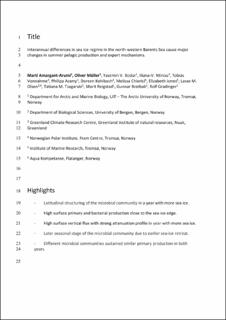| dc.contributor.author | Amargant I Arumi, Marti | |
| dc.contributor.author | Müller, Oliver | |
| dc.contributor.author | Bodur, Yasemin Vicdan | |
| dc.contributor.author | Ntinou, Iliana Vasiliki | |
| dc.contributor.author | Vonnahme, Tobias | |
| dc.contributor.author | Assmy, Philipp Kurt Wolf | |
| dc.contributor.author | Kohlbach, Doreen | |
| dc.contributor.author | Chierici, Melissa | |
| dc.contributor.author | Jones, Elizabeth Marie | |
| dc.contributor.author | Olsen, Lasse Mork | |
| dc.contributor.author | Tsagaraki, Tatiana | |
| dc.contributor.author | Reigstad, Marit | |
| dc.contributor.author | Bratbak, Gunnar | |
| dc.contributor.author | Gradinger, Rolf Rudolf | |
| dc.date.accessioned | 2024-04-15T07:59:42Z | |
| dc.date.available | 2024-04-15T07:59:42Z | |
| dc.date.created | 2024-01-04T11:09:28Z | |
| dc.date.issued | 2023 | |
| dc.identifier.citation | Progress in Oceanography. 2023, 220 . | |
| dc.identifier.issn | 0079-6611 | |
| dc.identifier.uri | https://hdl.handle.net/11250/3126437 | |
| dc.description.abstract | The Barents Sea is a highly dynamic and productive marine ecosystem and a hotspot of global warming. Variability in sea ice extent is a common feature in the Barents Sea with substantial movements of the sea ice edge on short-term, seasonal to interannual time scales. Historically the northern Barents Sea (north of 75◦N) has been ice-covered in winter, but recently it has become the area with most winter ice loss in the Arctic, and year-round ice-free conditions are predicted for the second half of the 21st century. These environmental changes have significant implications for the marine ecosystem. In this study we used contrasting sea ice regimes in August 2018 and August 2019 to explore the response of phytoplankton and bacterial production, microbial abundance, and vertical carbon flux in the north-western Barents Sea (between 76◦N and 83◦N) to the variability of sea ice. While the study area was ice-free in August 2018, extensive areas north of 79◦N were ice-covered in 2019. When the northern parts of the transect were still ice covered, diatoms and other larger phytoplankton were dominant and highest abundances were observed following the receding ice edge. In contrast, under ice-free conditions in 2018, the pelagic ecosystem resembled a post-bloom stage of the seasonal succession with higher abundance of small phytoplankton and heterotrophic protists and low vertical flux throughout the water column. While phytoplankton biomass, bacterial production and downward vertical flux of particulate organic carbon in the upper 60 m were on average higher in 2019, primary production and carbon export below the euphotic layer were comparable between both years. However, overall highest primary production, bacterial production and abundance of both photosynthetic and heterotrophic microorganisms were observed in surface waters (upper 30 m) in 2019, connected to the retreating ice edge, where also vertical particle flux was higher and characterized by a strong attenuation curve. The results clearly demonstrate that differences in ice cover affect the phenology of pelagic primary production and associated biological processes in the Barents Sea. | |
| dc.description.abstract | Mellomårlige forskjeller i havisregime i det nordvestlige Barentshavet forårsaker store endringer i den pelagiske produksjonen og eksportmekanismene om sommeren | |
| dc.description.abstract | Interannual differences in sea ice regime in the north-western Barents Sea cause major changes in summer pelagic production and export mechanisms | |
| dc.language.iso | eng | |
| dc.title | Interannual differences in sea ice regime in the north-western Barents Sea cause major changes in summer pelagic production and export mechanisms | |
| dc.title.alternative | Mellomårlige forskjeller i havisregime i det nordvestlige Barentshavet forårsaker store endringer i den pelagiske produksjonen og eksportmekanismene om sommeren | |
| dc.title.alternative | Interannual differences in sea ice regime in the north-western Barents Sea cause major changes in summer pelagic production and export mechanisms | |
| dc.type | Peer reviewed | |
| dc.type | Journal article | |
| dc.description.version | acceptedVersion | |
| dc.source.pagenumber | 22 | |
| dc.source.volume | 220 | |
| dc.source.journal | Progress in Oceanography | |
| dc.identifier.doi | 10.1016/j.pocean.2023.103178 | |
| dc.identifier.cristin | 2220499 | |
| dc.relation.project | Norges forskningsråd: 276730 | |
| cristin.ispublished | true | |
| cristin.fulltext | postprint | |
| cristin.qualitycode | 1 | |
